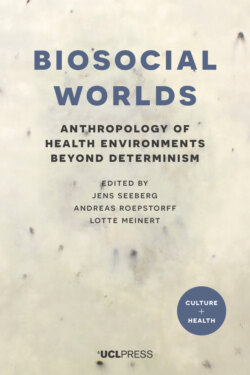Читать книгу Biosocial Worlds - Группа авторов - Страница 19
На сайте Литреса книга снята с продажи.
The reactive genome
ОглавлениеFollowing the announcements in 2001 that the human genome had been mapped (which was not at that time, strictly speaking, true) many surprises came to light, certain of which scientists had predicted prior to embarking on the Human Genome project (HGP), but that had been ignored. It was revealed that humans have approximately 20,000 genes, and not 100,000 as had been predicted. Numerous plants have many more genes than do humans, and the diminutive worm C. elegans has about the same number as ourselves. The size of a genome bears no relationship to its complexity, and the genome is not a template for the organism as a whole. Only approximately 1.2 per cent of DNA segments actually code for proteins, and the remaining 98.8 per cent was initially labelled disparagingly as ‘junk’ (Gibbs 2003). Given that DNA is among the most non-reactive, chemically inert molecules in the world, with no ‘power to reproduce itself’, as Richard Lewontin puts it (Lewontin 2000, 141), it is somewhat surprising in retrospect that so much significance was attributed to this molecule in the first place.
Non-coding segments of the genome initially appeared to have no obvious function. It soon became evident that they are frequently remnants of bacterial and viral genomes that serve to separate out the coding parts of the genome, thus inhibiting unwanted mutational changes during DNA transmission between generations. Moreover, numerous of these non-coding DNA sequences are highly conserved, implying that they have been present in genomes for hundreds of millions of years, strongly suggesting that they are crucial to both the fundamental processes of life and to evolutionary change.
Furthermore, it is well established that the activities of non-coding RNA (ncRNA) comprise a comprehensive regulatory system that functions to create the ‘architecture’ of organisms, without which chaos would reign. To this end, ncRNA profoundly affects the timing of processes that occur during development, including stem cell maintenance, cell proliferation, apoptosis (programmed cell death), the occurrence of cancer and other complex ailments (Mattick 2004). These findings greatly advanced understanding of the structure and function of the genome itself.
An important shift in orientation that commenced decades before the HGP, but which had remained largely quiescent, started to attract significant attention boosted by the post-genomic surprises. This shift was towards an investigation of the way in which environmental stimuli influence molecular activity. Today the majority of biologists, whatever their specialty, accept that cellular differentiation associated with human development is governed by processes akin to what was first described by the developmental biologist, embryologist, and philosopher Conrad Waddington in the mid-twentieth century as the epigenetic landscape; that is, a complex panorama of networks and feed-forward loops that determine when exactly stem cells are activated to form a lineage (Ramirez-Goicoechea 2013, 66). In other words, a chronological process that is context-specific. Numerous scientists also agree that these changes are not only initiated inside the body, but that external stimuli interact directly with individual genomes, resulting in epigenetic changes, or markers. Many such changes are stable, while others are reversible. Over the past decade molecular epigenetics has added numerous insights to this complex picture.
The assertion that multiple mechanisms of inheritance exist, and that variation in genomic sequences alone cannot account for phenotypic differences (Ramirez-Goicoechea 2013, 66–7) inevitably raises ontological concerns similar to those apparent in the days of Lamarck, regardless of the question of intergenerational inheritance, and epigenetics has been described as neo-Lamarckian by some researchers. Of course, given that neo-Lamarckism is grounded in molecular biology, its original claims are significantly modified, but the central tenet that environment makes a major contribution to the characteristics that are passed along to ensuing generations informs the foundational thinking of the burgeoning discipline of epigenetics.
The philosopher of science Evelyn Fox Keller sums up the situation thus: ‘The role of the genome has been turned on its head, transforming it from an executive suite of directional instructions to an exquisitely sensitive … system that enables cells to regulate gene expression in response to their immediate environment’ (Keller 2014, 2425). We live now with a ‘reactive genome’ (Gilbert 2003, 92). Furthermore, if genes are conceptualised as in effect ‘real’ entities, then they should be understood as composite rather than as unitary, somewhat analogous to ‘the solar system, or a forest, or a cell culture’ as Barnes and Dupré put it (Barnes and Dupré 2008, 53). A dynamic epigenetic network with a ‘life of its own’ – a context-dependent reactive system of which DNA is just one part has been exposed. Thus, contingency displaces determinism.
Gene regulation – above all how, and under what circumstances, genes are expressed and modulated – is central to epigenetic investigation, and whole cells, rather than DNA segments, are the primary targets of investigation. Effects of evolutionary, historical, and environmental variables on cellular activity, developmental processes, health, and disease have, in theory, become central to the research endeavour in epigenetics, although, to date, this is by no means the case in most basic science investigations into genomics.
Over the past decade, then, a profound shake-up has occurred in connection with knowledge about genes and how they function. The consolidation of the field of molecular epigenetics has brought about a demotion of the gene, and challenges the unexamined assumption held by many geneticists, researchers in human development, certain social scientists, and members of the public, that genes determine who we are.
Two decades ago, the neurobiologist Steven Rose argued that we must be concerned above all with the dynamics of life, that is, with process, and the continuous interchange between organisms and their environments. Our ‘lifelines’, he argued, constituted by life processes, generate our sense of self (Rose 1997).
